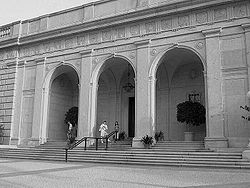Freer Gallery of Art
 |
|
| Established | 1923 |
|---|---|
| Location | 1050 Independence Avenue, Washington, D.C. |
| Coordinates | 38°53′17″N 77°01′39″W / 38.888135°N 77.02739°W |
| Director | Julian Raby |
| Public transit access |
|
| Website | |
|
Freer Gallery Of Art
|
|

Front entrance to the Freer Gallery of Art
|
|
| Built | 1923 |
| Architect | Platt, Charles A. |
| Architectural style | Late 19th And 20th Century Revivals, Florentine Renaissance |
| NRHP Reference # | |
| Added to NRHP | June 23, 1969 |
The Freer Gallery of Art and the Arthur M. Sackler Gallery form the Smithsonian Institution's national museums of Asian art in the United States. The Freer and Sackler galleries house the largest Asian art research library in the country and contain art from East Asia, South Asia, Southeast Asia, the Islamic world, the ancient Near East, and ancient Egypt, as well as a significant collection of American art. The gallery is located on the south side of the National Mall in Washington, D.C., contiguous with the Sackler Gallery. The museum is open 364 days a year (being closed on Christmas), and is administered by a single staff with the Sackler Gallery. The galleries are among the most visited art museums in the world.
The Freer houses over 26,000 objects spanning 6,000 years of history from the Neolithic to modern eras. The collections include ancient Egyptian stone sculpture and wooden objects, ancient Near Eastern ceramics and metalware, Chinese paintings and ceramics, Korean pottery and porcelain, Japanese folding screens, Persian manuscripts, and Buddhist sculpture. In addition to Asian art, the Freer also contains the famous Peacock Room by American artist James McNeill Whistler which serves as the centerpiece to the Freer's American art collection.
...
Wikipedia

